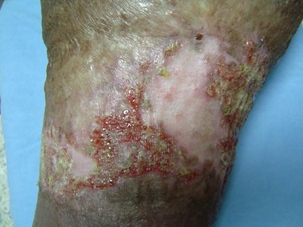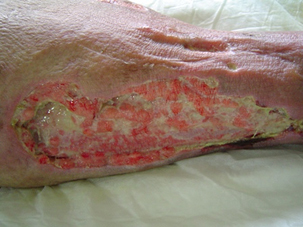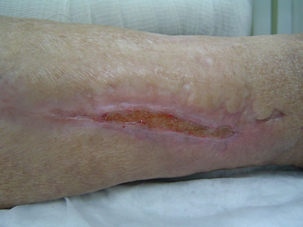Abstract
Telemedical wound care is one of the applications of teledermatology. We present our experience using telemedicine in the successful assessment and treatment of three patients with hard‐to‐heal ulcers. Three patients were seen at the PEMEX General Hospital in Veracruz, Mexico. The first patient was a 53‐year‐old man with hypertension, morbid obesity, chronic venous insufficiency, recurrent erysipelas, leg ulcers and lymphoedema. There was one ulcer on his left lower leg (20 × 10 cm) and one on his right leg (9 × 7 cm). The second patient was a 73‐year‐old woman with class III obesity and ulcers in her right leg, secondary to surgical debridement of bullous erysipelas. The third patient was a 51‐year‐old female with rheumatoid arthritis with one ulcer on each leg and chronic lymphostasis. Photographs with a digital camera were taken and sent weekly via email to a wound care specialist in Mexico City. The photographs allowed the expert to diagnose and evaluate the chronic wounds periodically. In the present cases, telemedicine allowed us to have a rapid evaluation, diagnosis and treatment. The images were of enough quality to be useful and small enough to be sent via regular email to the remote physician who immediately gave his feedback. The expert was confident to give therapeutic recommendations in this way, and we considered this method to be very cost‐effective, saving the patient and the health care system, especially in transportation.
Keywords: Developing countries, Skin ulcer, Telemedicine
Introduction
Telemedicine is defined by the World Health Organization as the practice of health care using interactive audio, visual and/or data communications. This includes health care delivery, diagnosis, consultation and treatment as well as education and transfer of medical data (1). Telemedical wound care is one of the applications of teledermatology.
The treatment of chronic leg ulcers requires frequent assessments of local wound status and adjustment of therapy (2). Chronic wound care and patient transportation represent important cost factors for health care systems. The availability of reasonably priced photographic equipment and quick electronic transfer of high‐quality digital images should make the assessment of wound status by remote experts possible (2). This type of care is particularly valuable for developing countries for it provides an opportunity for cheaper networking in difficult‐to‐treat cases and where wound care specialists are very scarce. We present our experience using telemedicine in the successful assessment and treatment of three patients with hard‐to‐heal ulcers.
Patients and methods
Patients with chronic wounds were seen at the PEMEX General Hospital in Veracruz, Mexico, by a dermatologist. Some cases need the evaluation and assessment of a wound care specialist, and photographs with a digital camera (Sony Cyber Shot, 3·2 mega pixels, Sony Corporation, Tokyo, Japan) were taken and sent weekly via email to the wound care specialist in Mexico City. The photographs allowed the expert to diagnose and evaluate the chronic wounds in a periodic base.
Results
Three patients with difficult‐to‐treat ulcers were seen at the PEMEX General Hospital in Veracruz, Mexico, between June 2006 and September 2006.
The first patient was a 53‐year‐old man with hypertension, morbid obesity, chronic venous insufficiency, recurrent erysipelas, leg ulcers and lymphoedema. The patient’s legs were deformed and discoloured secondary to haemosiderin deposition, and peau d’orange, varicose veins and lipodermatosclerotic changes were present (Figure 1). There was a 20 x 10 cm ulcer on the anterolateral calf of his left lower leg with moderate green exudate and a granulating wound base. Pseudomonas species was cultured, and p.o. levofloxacin was administered (this was the only antipseudomonal agent available at the hospital). In the right leg, a 9 × 7 cm ulcer with the same description was present. Because of the difficulty in treating this patient, the evaluation by a specialist was deemed necessary. Photographs were taken and sent weekly via email to the wound care specialist in Mexico City. Initially, the specialist suggested compression and silver sulphadiazine under non adherent gauze. As the patient became better, gauze with petrolatum (because of the lack of advanced dressings) was indicated and the patient quickly improved (Figure 2).
Figure 1.

A 20 X 10 cm ulcer on the antero‐lateral calf of his leg.
Figure 2.

After 5 weeks of treatment.
The second patient was a 73‐year‐old woman with a negative history for diabetes mellitus and hypertension and significant for class III obesity. She presented with bullae, erythema and an important swelling of her right leg and was admitted to the hospital on the surgical ward. Antibiotics were initiated (i.v. levofloxacin), and the possibility of a deep venous thrombosis was ruled out. Clinically, the diagnosis of ecthyma and bullous erysipelas was made. She developed two bullae and five ulcerations on her leg, and antibiotic treatment was changed to i.v. imipenem. Surgical debridement was indicated and performed by the department of surgery, and a dermatologist consulted for ulcer care. At that point, the patient had seven ulcers measuring 20 × 8 cm, 10 × 6 cm, 9 × 4 cm and four 2 × 2 cm (Figure 3). Once again, pictures were taken and delivered electronically. The wound care specialist then indicated compression, silver sulphadiazine and non adherent gauze, and the patient’s ulcer closed (Figure 4).
Figure 3.

Ulcers after surgical debridment of echtyma and bullous erysipela.
Figure 4.

After 9 weeks of treatment.
The third patient was a 51‐year‐old woman with rheumatoid arthritis diagnosed 40 years ago and treated with leflunomide, prednisone, ibuprophen and tramadol. She had severe deformities of the four extremities.
Five years ago, she began with ulcers on the legs: the right leg with a linear ulcer of 2 cm of diameter surrounded by verrucous skin and in the left leg, ulcer of 1·5 cm of diameter also in a verrucous skin (Figure 5). There was no evidence of wound infection. We sent the photographs to the wound care expert and the diagnosis of chronic leg ulcer associated to lymphostasis was made, and we initiated treatment with solid petrolatum and compression and the ulcer healed.
Figure 5.

Ulcer on a verrucous skin because of chronic lymphedema.
Discussion
We present these three patients with difficult‐to‐treat ulcer who were successfully managed by a wound care specialist using telemedicine. Of the three patients, in two, the ulcers healed completely and in one, the ulcers decreased in size. It is a very useful tool in our country because there are only few wound care specialists in hospitals.
Chronic wounds and leg ulcers represent an important cost to the health care system, and transportation is estimated to represent an important percentage of the total costs (1). Telehealth provides health care services at distant sites using electronic communications and can be a marvellous bridge between rural hospitals and tertiary centres 3, 4.
In our case, telemedicine allowed us to have a rapid evaluation, diagnosis and treatment for our patients. The images were of enough quality to be of use and small enough to be sent in a regular email to the remote physician who immediately gave his feedback. The expert was confident to give therapeutic recommendations in this way, making this method very cost‐effective and saving the patient and the health care system resources used for transportation. In the literature, this method has shown to be useful for the quality of the images is close to excellence, and the consulted physician feels confident in recommending further treatment strategies and in planning further wound assessment via the internet 1, 2, 4, 5, 6, 7, 8, 9, 10. Also, in some studies, a high concordance between direct consultations and electronic consultations was found in the assessment of chronic leg ulcers 1, 2. Weekly teledermatological monitoring of the ulcers in cooperation with home care nurses has obtained good results, with 71% of ulcers decreased in size, 31% healed completely, whereas 22% increased slightly in size despite the teledermatological monitoring (9). The acceptance of teledermatological monitoring was very high in our patients, as it is reported in other studies, also by the nurses and the wound care specialists 9, 10, 11. In our case, the response was mostly via email, but in some cases, the communications have been by phone 1, 8. It has been reported that the new generation of mobile telephones is the ideal tool for this task because they are small portable devices, images of acceptable quality can be taken and sent immediately via email from the patient’s bed. The remote physician has the image on a computer screen and can immediately talk to the nurse or the physician via the mobile telephone (1). We believe that despite this fact, the need to purchase the telephone and the long‐distance fees may increase the costs.
Telemedicine has also been used to give a distance wound care course about wound treatment that demonstrated to have good results, in fact, a comparison between pre‐ and posttest results showed that students scored better on the posttest (P < 0·0001) (12).
Teledermatological wound care offers great potential for the future in chronic wound care. By reducing the need to travel long distances to the hospital or to consult a physician, telemedicine decreased our costs and improved the quality of life for patients with chronic wounds while still maintaining high standards of wound care.
References
- 1. Braun RP, Vecchietti JL, Thomas L, Braun RP, Vecchietti JL, Thomas L, Prins C, French LE, Gewirtzman AJ, Saurat JH, Salomon D. Telemedical wound care using a new generation of mobile telephones: a feasibility study. Arch Dermatol 2005;141:254–8. [DOI] [PubMed] [Google Scholar]
- 2. Salmhofer W, Hofmann‐Wellenhof R, Gabler G, Rieger‐Engelgogen K, Gunegger D, Binder B, Kern T, Kerl H, Soyer HP. Wound teleconsultation in patients with chronic leg ulcers. Dermatology 2005;210:211–7. [DOI] [PubMed] [Google Scholar]
- 3. MacLellan K. Telemedicine and rural care. CMAJ 2005;173:127. [DOI] [PMC free article] [PubMed] [Google Scholar]
- 4. Ratliff CR, Forch W. Telehealth for wound management in long‐term care. Ostomy Wound Manage 2005;51:40–5. [PubMed] [Google Scholar]
- 5. Debray M, Couturier P, Greuillet F, Hohn C, Banerjee S, Gavazzi G, Franco A. A preliminary study of the feasibility of wound telecare for the elderly. J Telemed Telecare 2001;7:353–8. [DOI] [PubMed] [Google Scholar]
- 6. Hofmann‐Wellenhof R, Salmhofer W, Binder B, Okcu A, Kerl H, Soyer HP. Feasibility and acceptance of telemedicine for wound care in patients with chronic leg ulcers. J Telemed Telecare 2006;12 (Suppl. 1):15–7. [DOI] [PubMed] [Google Scholar]
- 7. Jones SM, Banwell PE, Shakespeare PG. Telemedicine in wound healing. Int Wound J 2004;1:225–30. [DOI] [PMC free article] [PubMed] [Google Scholar]
- 8. Reilly J, Noone A, Clift A, Cochrane L, Johnston L, Rowley DI, Philipps G, Sullivan F. A study of telephone screening and direct observation of surgical wound infections after discharge from hospital. J Bone Joint Surg Br 2005;87:997–9. [DOI] [PubMed] [Google Scholar]
- 9. Binder B, Hofmann‐wellenhof R, Salmhofer W, Ocku A, Kerl H, Soyer HP. Teledermatological monitoring of leg ulcers in cooperation with home care nurses. Arch Dermatol 2007;143:1581–2. [DOI] [PubMed] [Google Scholar]
- 10. Wilkins EG, Lowery JC, Goldfard S. Feasibility of virtual wound care. a pilot study. Adv Skin Wound Care 2007;20:275–6. [DOI] [PubMed] [Google Scholar]
- 11. Rees RS, Bashshur N. The effects of TeleWound Management on use of service and financial outcomes. Telemed J E Health 2007;13:663–74. [DOI] [PubMed] [Google Scholar]
- 12. Ribeiro MA, Lopes MH. [Development, implementation and evaluation of a distance course about wound treatment]. [Article in Portuguese] Rev Lat Am Enfermagem 2006;14:77–84. [DOI] [PubMed] [Google Scholar]


